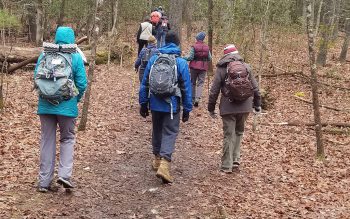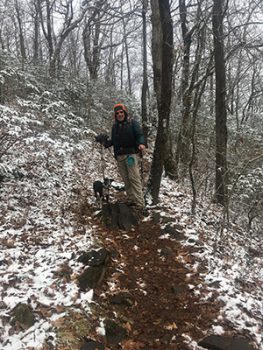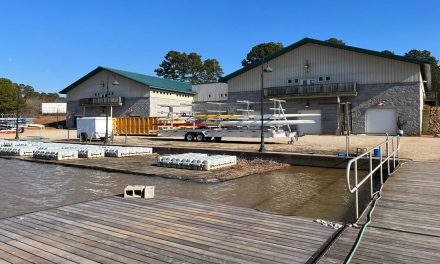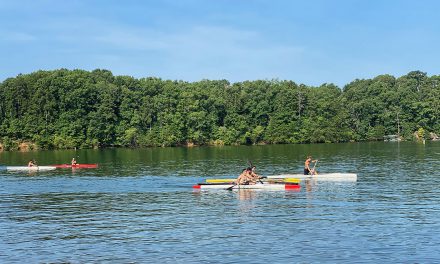
Winter hikers hit the BMT during a January event.
Evergreen needles glisten with hoarfrost or droop under powdered flakes. Tree trunks rise stark, dormant and naked without their foliage. Snatches of color in the neutral backdrop of gray and brown emerge with vibrancy. Beds of velvety green moss soak up sun. Partridge berries and hollies flaunt flecks of red. Views of valleys, ridges, waterfalls and lakes offer foot travelers an awesome perspective usually masked by leaves in summer. The beauty of winter beckons hikers to the foothills around Lake Lanier and the mountains in the headwaters.
The spectacle of winter also creates particular hiking conditions that require more vigilance to stay safe and ensure a positive experience. “In winter, because it’s cold and it gets dark earlier, it’s a little riskier,” said Ken Cissna, president of the Benton MacKaye Trail Association. The club, named for an American forester and conservationist who pioneered long trails in the Appalachian Mountains, organizes several hikes a week, mainly in North Georgia. Hikes include sections of the 285-mile Benton MacKaye Trail and other trails in the Georgia mountains, including treks up Yonah Mountain and Blood Mountain in Northeast Georgia.
“The normal precautions are more important” on trails in winter, Cissna said. Ill-preparation or a foray off-trail can expose hikers to hours in cold and darkness or injury on slippery terrain. “Particularly in winter, you can get in trouble more quickly,” Cissna said.
“Winter hiking is a little bit different, but a lot is the same,” said Cissna, whose recent BMTA column lists his general tips (see sidebar). For one thing, hikers dress differently for the cold. Cissna recommends layers of wicking synthetic fabrics that won’t hold moisture if a hiker sweats or gets wet. If a hiker gets warm with exertion or milder conditions, they can always take off a layer and store it in their pack. “But you can’t add a layer” if you don’t have it, Cissna said. He added that if cotton clothing gets wet, it stays wet. “If it’s wet, cold and windy, you’re at risk” with cotton.
But long before hikers begin donning base layers and pulling on warm socks, Cissna advises they check the weather for the vicinity they plan to walk. “What’s the temperature? The temperature at home will not be the same at the top of Blood Mountain. But you don’t have to go (4,459 feet) to the top of Blood Mountain to experience different weather than your own backyard,” Cissna said. Is it icy, windy, foggy, storming? Some trails are accessible only by unpaved Forest Service roads. Are the roads treacherous with ice? Are they closed due to poor conditions or downed trees? Forest Service websites, such as the Chattahoochee-Oconee National Forest site, www.fs.usda.gov/conf, provide alerts and warnings, but may not post the details travelers need to decide whether to make a trip.

Ken Cissna, Benton Mackaye Trail Association president, and his dog Artie, along the BMT
Hike preparation also includes being aware of sunset time. Shadows creep into the woods a half hour or more before the sun sets, making it difficult to see trail blazes or the trail itself. Plan to start a hike in plenty of time to complete it before dark.
Cissna advises hikers to avoid icy trails. “Most people don’t have the equipment (or the experience) to handle them,” he said. If hikers come upon icy spots, Cissna recommends walking around them. He said BMTA hikes rarely involve water crossings in winter. Occasionally a hike might cross a small creek, but BMTA hikers mainly take to the ridges in winter and avoid river crossings, where icy rocks and near-freezing water can put a hiker in serious danger miles from help.
“Most people with bad outcomes are normally people who got off the trail,” Cissna said. He instructs hikers to stay on trail, don’t hike alone, and stay together. Following these guidelines enhance safety in winter.
The uniqueness of winter hiking is rewarding. “The trails look different in winter,” Cissna said. “You have fall color and spring wildflowers … winter beauty has views, everything looks different.” The long-time Floridian who moved to North Georgia in retirement relishes what mountain winters offer those who venture out. “I love to hike in the snow,” he said, especially up on Springer Mountain where on the southern terminus of the Appalachian Trail and Benton MacKaye Trail every branch and pine bough might be coated with snow. A trail in winter, with or without snow, offers a fresh, exhilarating experience to those who respect the season and heed its temperament.
Tips before you go hiking
Ken Cissna, president of the Benton MacKaye Trail Association tells hikers that advance planning may prevent problems or lessen their severity when they do occur. Appropriate planning is especially important in winter, when cold and early darkness may exacerbate troubles on the trail. Before you pack, know the answers to the following questions:
- How long is the hike and are you in shape for it?
- Are there any Forest Service advisories about the particular section of the trail?
- Do you know what type of blaze or sign marks the trail to guide you on your journey?
- What is the weather forecast of the trail’s location?
- Do you have enough time to complete the hike before dark?
- Who knows where you will be and when you should return?
- If you plan to bring your loyal, four-footed companion, what are the regulations for dogs on the trail and is your dog in shape for this hike?







